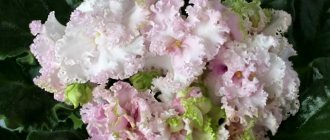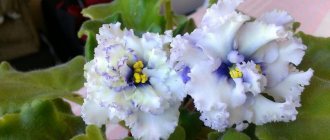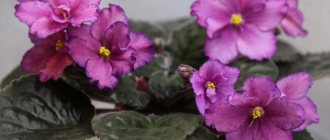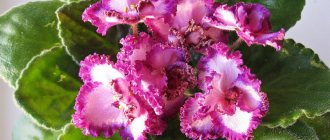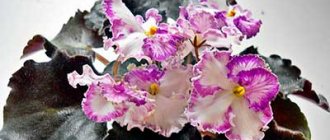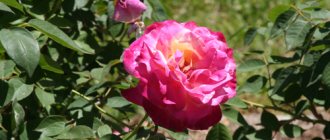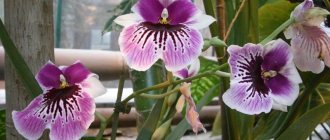Violets are one of the most popular indoor flowers. They were loved for their delicate flowers of various sizes and colors.
But having bought their favorite variety, not all flower growers wait for lush flowering.
What mistakes are made when growing violets, and how to avoid getting into trouble, read the article.
Types and varieties of Saintpaulia, description of indoor plant
All violets were divided into several groups to facilitate orientation among the many species. There are three groups :
- collectible;
- variegated;
- industrial.
Variegated varieties are characterized by the brightest color of the leaves, which can be painted in different colors . They often have a border around the edges. The first variegated varieties produced small and simple inflorescences, but later breeders developed species distinguished by large double flowers of different colors.
Industrial Dutch violet
Industrial - intended for mass cultivation on special plantations . They are available for purchase in large quantities. Their appearance is the simplest. These plants are mainly used to decorate banquet halls and are placed in offices and government institutions. These varieties bloom actively for a long time.
Collectible
They are characterized by large inflorescences measuring from five to seven centimeters. They differ from other species in that almost all of them have large double petals of a wavy shape, painted in a wide range of colors : from snow-white to rich blue shades. The leaves also vary in color and have wavy edges.
The most beautiful and unusual varieties are collected at exhibitions. Complex collectible varieties require more time and effort to successfully grow and properly care for. Labor is rewarded with gorgeous flowering. Collectible violets include : Lemon Snow, Willodene, Gift for a Loved One and many others.
General description of the plant, flowers, appearance
The variety was bred through selective breeding. In 2010 it was presented at a flower exhibition. Photos of Eve's violet present a very pretty picture, since thanks to the huge number of pedicels the plant looks like a blooming ball. Flowering lasts about 2 months.
All the buds bloom at the same time, so the ugly rosette is masked by lush violet petals. Due to the fact that the plant produces a huge number of pedicels, their fragility is compensated by supporting each other.
Violet Eve prefers the sun, so the color of the buds, leaves, number of peduncles and quality of flowers will depend on the location of the flowerpot. It is believed that the variety blooms early and pleases the eye with delicate inflorescences for a long time.
Difference in names
Saintpaulia and Uzambara violet are the names of the same plant, which is cultivated at home. Saintpaulia is the Latin scientific name, and Uzambara violet is the folk name . People began to call Saintpaulia Uzambara violet because in its natural environment the plant is found in the Uzambara Mountains.
Viola is the Latin name for the violet that is grown in gardens.
Purple
Currant dessert
They take the shape of stars, they are very fluffy and semi-double. Along the edges of the petals there is a fringe of an unusual color : it resembles the shade of jam made from black currants. The velvety leaves are colored green. The variety is quite unpretentious, suitable for beginners.
Winter rose
The shape of the flowers strongly resembles pink inflorescences, which is why the variety has such a name. The petals are dark blue-violet. There is a thin snow-white edging along the edges . Small leaves are colored rich green. Winter rose conveys the qualities of the variety well.
The leaves have serrated tips and form a compact rosette of bright green. They are classified as semi-double. They grow to impressive sizes and are colored blue-violet. Along the edges there is a wide, blurry white border .
Aly's Blizzard Bunny
The snow-white flowers are small in size and strongly reminiscent of stars. The variety is classified as semi-double . The heart-shaped leaves are a rich green color. This species is very popular among amateur gardeners.
Snow lace
The variety is characterized by lush double flowers of a snow-white hue. There is a bluish spot in the center . The edging of the petals shines with a barely noticeable greenish tint. It blooms very actively and luxuriantly. The leaves are colored light green.
The bride's bouquet
It was bred by Russian breeder Konstantin Morev. Large delicate white flowers in the shape of a star with wavy edges are very similar to a wedding bouquet . Blooms profusely. The petals have an even color, there are no inclusions or patterns.
A variety of fabulous beauty. Large double flowers consist of rich pink petals, along the edges of which lilac inclusions are scattered . The wavy edges of the petals are decorated with a thin light green border. Flowers bloom on powerful peduncles. Blooms profusely if the necessary conditions are met.
The variety was released in 2011. Blooms large double flowers of a rich pink hue . Along the edge of the petals there is a lilac border with a thin snow-white line. The leaves are dark green. Looks great on the windowsill.
The foliage is colored green. Large double flowers resembling a ball bloom in the middle of the rosette. The petals have a wavy edge. The flowers are located very close to each other, which creates the impression of a huge bouquet . Very popular at exhibitions. Many people acquire leaves of this variety.
Lilac beauty
The variety is distinguished by large purple flowers with speckles of rich lilac color in the center. There is a dark border at the edge of the petals. The flower stalks are powerful, the rosette of regular shape consists of round leaves . This variety is easy to care for and is suitable for beginners and even children.
Favorite daughter
The flowers are a rich lilac color with a dark purple border. The serrated leaves are round in shape and emerald green in color . The reverse side has a clear raspberry tint. Flowers are born small and dark. As they develop, they become lighter. It can lift leaves up, so it needs a lot of space on the windowsill. Beautiful and lush flowering almost always pleases the gardener. They bloom for two to three weeks.
Read also: Characteristics of the best grape varieties
Blue Dragon
A widely known variety of Sorano selection. Almost all collectors have this variety. Popular for its large, soft blue flowers . A white-greenish border stretches along the edges of the petals. The variety is quite capricious. It needs a natural source of light and does not tolerate agricultural errors.
Blue Danube
Bred by Russian breeders. It is characterized by large flowers that reach five centimeters in size. The petals are colored pale blue. Matte leaves with wavy edges have small denticles at the end . This variety needs good lighting and proper watering. The abundance and duration of flowering depends on temperature.
Blue Lagoon
The variety is characterized by large semi-double flowers of a rich blue hue, reminiscent of a star shape. It has a blue spot in the center, and a purple border runs along the edges. When there is insufficient light, it raises the leaves upward . Flowering duration is two months. Easy to care for, even a beginner can grow it.
Variegated
lemon snow
The flowers are painted snow-white with lemon-colored rays. The middle and edges have a bluish tint. The leaves are variegated and painted a rich green color . There is a white border along the edge of the leaf.
Willodene
A variety with unusually beautiful variegated leaves. Peach flowers with a greenish edge are not the main attraction. At exhibitions, attention is paid to the wavy leaves, colored emerald , diluted with pink and white spots.
Gift for a loved one
Of particular value are the rich green leaves with sharp tips and pink-white edging . The flowers are blue. There is a purple border along the edge. Enjoys great success at exhibitions. Quite an unpretentious variety.
Ampelous violets are used for growing in hanging pots. They decorate hanging flower beds and gardens. They have several growing points, long stems hanging down, and a large number of side shoots. The most popular varieties of ampelous violets are Trinket Summer Skyes with rounded green leaves and blue flowers and Robs Humpty Doo with light leaves and snow-white flowers.
They need a lot of light. They are able to bloom throughout the whole year . In winter, the plant is provided with additional lighting.
The rosette of miniature violets does not exceed fifteen centimeters in size . At the moment, about two thousand varieties of mini-violets are known.
Many collectors only collect miniature violets. Caring for miniature violets has some features : they are less whimsical than their larger counterparts.
Among the mini-varieties, Avatar can be distinguished with simple semi-double flowers of a soft blue hue and variegated leaves. Flower growers are also attracted by a delicate variety called My Angel . Simple flowers on powerful peduncles are colored pink. The leaves are soft green in color and have a wide snow-white edge.
Violet Lyon's Early Spring (S. Sorano)
Lyon's Early Spring is a Usambara violet, this flower belongs to the Gesneriev family. Genus – Saintpaulia Hybrid.
Paul Sorano heads Lyndon Lyon Greenhouses, a well-known company among violet lovers. Sidney Sorano worked on this variety in the greenhouse
Photo and description of the variety
Photo of Lyon's Early Spring violet.
The name of the violet Lyon's Early Spring [Lyon's Early Spring] means "Early Spring".
The flowers are large, simple and semi-double. White flowers with a lavender eye and an equally wide lavender border complement a beautiful rosette of green and white foliage. The flowers are large, about 7 cm.
Most often, in the first bloom, simple star flowers bloom, and already in the second bloom, the violet reveals its full potential.
Variety – standard.
A beautiful variegated variety. Leaves with contrasting green and white patterns - Tommy Lowe, bordering variegation.
Sports
The variety is very sporty, there are two types:
- The first most famous fixed chimeric was called PC-Wheel of Fortune , breeder Svetlana Repkina. A gorgeous bouquet of huge chimeric flowers measuring 6-7 cm. White star flowers with blue-lilac rays. The flowers are simple and semi-double with wavy edges;
- the second is more common. The rosette is standard with variegated foliage, the flowers are large, but unlike the variety, they are blue-violet in color.
Development nuances
The rosette must gain enough leaf mass before flowering.
Important! It best conveys varietal characteristics when propagated by stepsons.
Lyon's Early Spring is very responsive to poor growing conditions . The rosette is sensitive to overwatering and drying out of the soil. It also reacts poorly to excess or lack of sunlight.
Under favorable growing conditions, the rosette quickly increases its leaf mass and within 8-10 months pleases with a lush head of flowers .
Reproduction methods
The variety is very sporty . Most often, flower growers use 2 propagation methods:
- leaves of the mother plant . Often, out of 5-6 children, only 1 correct violet can be obtained;
- stepchildren _ The second method is most favorable for obtaining violets with varietal characteristics.
Features of flowering
Like all variegated violets, this variety does not like heat . If the room temperature is too high, the variety darkens or may even go into sport.
Peduncles are not very durable , but not the worst option either.
With good care, a lush head of flowers will delight you with every bloom.
Flowers do not stay fresh for very long. It costs two weeks.
The lifespan of each bud is about two weeks.
Reviews
Igor, Petro
Alyona. “The variety is delicate, the rosette is beautiful. The variegated leaves so harmoniously highlight the amazing flowers.”
What varieties are cultivated at home?
At home, simple violets of the industrial group, variegated and collection ones are grown. Beginners are advised to start simple violets to gain experience in caring for them. An experienced florist can already grow complex breeding varieties. A huge number of species are grown at home. Experts have developed about thirty-two thousand varieties of indoor Saintpaulias, differing in many parameters : color, shape, leaf structure and rosette.
About twenty species of Saintpaulia grow in the wild. In natural conditions there are :
Velvet Saintpaulia
On the front side the leaves are painted green, and the back side has a reddish tint . The inflorescence is made up of purple flowers with a dark central part.
Violet flower Saintpaulia
Short stems bear blue-violet flowers and rich green heart-shaped leaves. The diameter of the rosette can reach sixty centimeters.
Saintpaulia Grote
Belongs to the ampelous varieties. The pubescent leaves take on a rounded shape . The lilac-blue flowers do not grow more than two and a half centimeters.
Violet Lyon's Spectacular
Usambara violet Lyon's Spectacular of the Gesneriaceae family. Saintpaulia hybrid.
The Lyon's Spectacular variety has long been loved by violet lovers. In the greenhouse, breeding was done by Sidney Sorano.
Photo and description of the variety
Lyon's Spectacular (S. Sorano) is already a retro variety, but it has been losing its popularity for many years. Huge semi-double frilled star flowers with a blue eye, blue border and shadows will be a favorite in any collection. Flowers easily reach 7 cm.
The socket is standard , large in size, flat in shape. The foliage is medium green and simple. The leaves have a rounded shape and a light underside.
If the inside of the baby is dark, the flowers will be dark.
An adult rosette grows huge and spreading , with gnarled leaf petioles. And this is the peculiarity of Saintpaulia. But collectors forgive this variety for its sloppiness because of its huge and bright flowers.
The variety does not have variegated foliage . The foliage is medium green.
Sports
Very athletic. To obtain a varietal plant, a cutting from the mother bush must be light-colored. It is very prone to darkening , it can sport after varietal flowering, and then return and bloom according to the variety.
Sport is blue-violet in color with dark undersides of the leaves.
Features of flowering
With each flowering it darkens , this is a varietal feature. By the third flowering it may become completely dark. In spring it blooms most often with white-blue flowers with a blue eye and the same border, and by autumn it can bloom with dark blue flowers.
From time to time it is necessary to root a light cutting with a flowering rosette with varietal characteristics.
Attention! Sometimes among varietal specimens there is a line with falling flowers.
How does a plant develop at home?
With good care, the children quickly increase their leaf mass and grow before our eyes.
About a year passes from the moment of planting a leaf cutting to the receipt of an adult specimen . Some rosettes bloom magnificently even in the starter phase.
Violet is best propagated by stepsons. But a simpler method - with a leaf - is also suitable. The main thing is to choose a light leaf even on a floating rosette.
And when he gives birth to children, leave those whose undersides of the leaves are not dark.
Flowers and peduncles
the heat of summer, the flowers often float and turn blue; as soon as the temperature in the room drops to normal, the flowers bloom again according to the variety.
The best flowering of Saintpaulia is in spring and autumn.
The peduncles are long, strong , and easily cope with heavy and large flowers.
Blooms readily . The main thing is not to forget about fertilizing when the violet is preparing to bloom.
Lyon's Spectacular blooms long and profusely.
It blooms for a long time at a comfortable room temperature and moderate indoor humidity.
Reviews
Maria. “I got a neat rosette and not at all uneven. The flowers are simply gorgeous, up to 7 cm. The variety is very unpretentious and blooms frequently.”
Lyudmila Vladimirovna. “I grew violets both on a wick and with regular watering. A huge rosette grows on the wick. But all this sprawl is more than compensated for by the huge and gorgeous flowers.”
Useful properties of violets
Indoor violet can not only please the eye of the gardener, but also help with various diseases. It has a beneficial effect on the body during kidney inflammation, bronchitis, joint pain and atherosclerosis . A decoction is prepared from a Saintpaulia leaf poured with boiling water and added to tea. Take it within 24 hours. You can bathe children in violet decoction. This method will help cure scrofula, rickets, eczema and skin rashes. Violet tinctures help with tinnitus after childbirth. With the help of a violet leaf you can get rid of insomnia and neuroses.
The plant contains toxic substances that, if used incorrectly, poison the body . Between courses there is a break of a month.
It is difficult to select the best varieties of Saintpaulia given the huge variety. The most beautiful, of course, are the collection varieties . The most popular among gardeners are Winter Parasol, Adonis, Rococo Pink and many others.
Distinctive features of Eve in comparison with other varieties
Violet Eve differs slightly from its relatives, but the species still has unique features. It is worth paying attention to the following nuances:
- Non-standard coloring, which depends on how much light the plant receives.
- A weak and unsightly rosette often does not support flowers, so several flower stalks can intertwine with each other.
- Long flowering, which can last about 2 months.
- Ease of care and breeding, as well as love for direct sunlight, significantly distinguish the presented variety from the rest.
Otherwise, Eva is completely similar in terms of care to other violets.
The best varieties of Sorano violets
Usambara violets are very often associated with America. However, many lovers are far from understanding what the Saintpaulia culture is like in the United States. For American breeders, this is a business in breeding their own varieties. That is why the approach to newly created hybrids is commercial. “This variety is interesting, they will buy it, but this one is uninteresting, but it can be left in the catalog of new products for variety.” The result of this approach is that not all varieties of American selection are attractive. In our market, the words “foreign novelty” sound fascinating. New varieties are ordered, advertised, and people fight for them. At the same time, domestic selection is sometimes not paid attention to.
Read also: The best whiskeys
In the United States, interest in violets is steadily declining. Ours is growing. This is mass, popular love. Americans are pragmatic, Russians are spiritual. They will manage without the most necessary things, but not without a painting, a book, or a favorite plant. Americans have a typical mindset; they want a simple, unambiguous recipe for all occasions. Russians have their own special opinion on everything. For example, each gardener has his own soil composition for his favorite plants. Residents of the United States do not understand this - why look if there is already a ready-made, tested, optimal option?
Americans strive to fit everything into a certain stereotype, while Russians always strive to invent something new and unusual. Thus, Americans are very scrupulous about the symmetry and compactness of the rosette and the neat appearance of the foliage. Kent Stork instructed his student: find good leaves and “attach” flowers to them. As a result, decades are spent selecting the “impeccable” variety. Seedlings are crossed with each other, propagated again and again by leaf cuttings to check the shape of the rosette, and so on. Americans reject the hybrid if the edge of the leaf is strongly curled, that is, they fight against what decorates the violet. Moreover, it is known that the wavy edge of a flower usually genetically correlates with the wavy edge of a leaf. But Americans manage to produce violets with fringed flowers and smooth, straight leaves! Another example of American taste: the abundance of varieties with soft fantasy is amazing. The preferences of Russians are opposite: the more contrasting the pattern, the better and more beautiful it seems to them. I know from myself: sometimes you walk around a store, looking at the windows with new products, and you can’t choose anything - all the violets merge into one lilac-pinkish background with small, expressionless specks of fantasy. There are many more such examples of differences in approaches and tastes.
Special talk about the American soilless mixture for violets (perlite, vermiculite, high-moor peat in equal parts). If we talk “by science”, then nothing can grow in such a mixture. Perlite and vermiculite are good mineral supplements. But if there are more than half of such rippers in the soil (60 percent), then the balance of nutrients is disturbed, and the plants develop a characteristic yellowing of the lower leaves. But it is interesting that Americans do not grow Saintpaulia in such a substrate, although they recommend it as an ideal from the pages of their magazine. At first, they managed to use a mixture without peat at all (50% vermiculite and 50% perlite), then, on the contrary, they switched to growing in only peat (vermiculite disappeared from sale, and perlite began to be produced of poor quality). Recently we have returned to using rippers. Thus, P. Sorano uses a ready-made substrate, to which perlite has already been added in small quantities.
Another interesting example: many people do not know that for Americans, soilless mixture and wick irrigation are inseparable from each other. But, naturally, watering through a wick is a delicate matter that requires attention and accuracy. In the case of constant humidification, the water rises upward all the time due to the capillary effect. On the pages of the African Violet Magazine there is a heated debate going on: what forms in the upper part of the pot - mold, fluoride salts or some other deposits. It turns out that Americans regularly clean off and throw away the top 2 centimeters of soil. So much for the perfection of American technology!
It never ceases to amaze us that Americans achieve their excellent results through simple painstaking work in the most ordinary greenhouses, facing the same problems that arise in our country. I had to work in the conditions of our old “antediluvian” greenhouses. In summer, plants suffered from burns at high temperatures and high humidity, in winter - from poor lighting and frost. The plants were watered hastily with a hose. It seemed to me that it was impossible to grow violets in such conditions. And so I was surprised to learn that the P. Sorano company, which supplies the whole world with its masterpieces, uses the “old fashioned” method of watering from a hose! Moreover, the trays with the planted plants are also filled with water, and the workers are forced to lift them to remove excess water. As they say, technology is on the verge of fantasy!
No less touching is the story of P. Sorano about how he fought thrips in greenhouses. For several years in a row, every Saturday for 4 hours he had to treat all the plants with insecticides. In the process of performing this backbreaking work, the thought more than once came to his mind to quit violet breeding. Perhaps this would have happened if Paul had not eventually found an effective drug, Conserve.
The entire history of hybrid violets is connected with the USA, and American breeders have incomparably more experience than we do. In America there is a galaxy of strong breeders working in different directions. They have much more opportunities - they have entire greenhouses at their disposal, not apartments. Such a scale allows them not only to create a huge number of varieties, but also to conduct long-term research into new areas of breeding. Russian hybridizers are in less advantageous conditions; almost all of them are amateurs. They care little about the situation. They breed varieties for their own pleasure, not thinking about commerce in the first place.
Read also: The best wheat varieties in the world
There are many circumstances that do not work in favor of domestic selection. Take a random catalog of any Moscow breeder and you will see the absolute predominance of American varieties. The psychology of the masses is driven by inertia. They will buy Sorano violets because they bought them ten years ago. The market is flooded with American varieties. The average person, who can purchase any violets, since the assortment allows, does not care at all whether domestic violets exist at all, even if they are superior to American ones. In addition, the Russian person’s sense of patriotism is not as developed as that of other peoples. Therefore, Russians will buy overseas varieties, not Russian ones. And American violets will hold the palm for a long time here and throughout the world.
Many people think that Saintpaulia breeding has exhausted itself. However, despite the apparent diversity of modern violets, not everything has been said in their selection. There are no rich yellow varieties, few pure red, brown, completely black. The shape of the flower remains completely unplayed, which conceals a reserve of diversity. There are few Saintpaulias that are multi-fantasy and multi-colored. Even in the variety of chimeras, which have been bred in America for a long time, the last word has not yet been said.
And therefore, at the beginning of each year, Russian violet lovers will look with undisguised curiosity at the websites of American breeders to see new varieties there.
Violet Iceberg (LLG/Sorano)
Breeder
The name of the breeder, written with a slash, means that the Iceberg variety was created by the world famous Lyndon Lyon Greenhouse (LLG). New varieties have been bred in this place for 65 years.
The founder of the greenhouse, Lindon Wildo Lyon, while visiting, saw a leaf stuck in a flower pot.
They explained to the surprised guest that a new plant, and perhaps more than one, would soon emerge from the leaf, and was given a pot with a leaf. Lindon was so fascinated by the flowering that he later:
- I got myself a few dozen more varieties;
- He opened a company for their sale and cultivation;
- And then I became interested in their selection.
Important! It was at Lyndon Lyon Greenhouse that the first double flower with petals of the same size was produced.
In 1982, Lyndon handed over his life's work to his grandson Paul Sorano. in the LLG greenhouse :
- Lyndon Lyon;
- Paul and Sydney Sorano.
Now their violets are known throughout the world . One such violet is the Iceberg Violet (LLG/Sorano).
Violet Iceberg was discovered by Lyndon Lyon.
Photo and description
The Iceberg variety (LLG/Sorano) is characterized by double or semi-double snow-white pearlescent stars. Along the corrugated edge of the petal there is a thin stripe of blue ink .
The leaves are medium green, simple, with a strongly wavy edge . Prone to yellowing. The rosette can reach 30 cm in diameter. The leaves grow upward; the rosette disintegrates only under conditions of high humidity.
The presented violet has sports.
The sport Iceberg-chimera is officially established in the CIS The sport has white chimeric stripes on its blue double flowers. Chimera gives out often and naturally.
latest comments
- And my favorite photo 4 hours 6 minutes ago
- One of the interesting seedlings from 4 hours 7 minutes ago
- There will be photos of 2 different ones 4 hours 12 minutes ago
- Polina!) Better late than 5 hours 51 minutes ago
- Thank you! 6 days 22 hours ago
- I understand your desire for 6 days. 22 hours ago
- Thank you very much! 1 week 2 days ago
- Beauty! 1 week 2 days ago
- Beauty! 1 week 2 days ago
- Alina, thank you for 1 week 6 days. back
- I love watching yours 2 weeks 2 hours ago
- By the way, I wanted to say something 2 weeks 19 hours ago
- Polina, thank you. Glad 2 weeks 1 day ago
- Tanya, beauty, as always! 2 weeks 1 day ago
- Couldn't compress photo size for avatar 2 weeks 2 days ago
- One day 6 violets have brown spots and burns on their leaves 2 weeks 3 days ago
- Tatyana, thank you very much!)) 3 weeks 6 days. back
- Hodss-Pelmeshek (conditional) 3 weeks 6 days. back
- Hodss-Pelmeshek (conditional) 3 weeks 6 days. back
- Hodss-Pelmeshek (conditional) 3 weeks 6 days. back
Comments
Nice to see Polina in this
Author: Alina Akzigitova , Almetyevsk, January 28, 2016 - 11:55 editor | textile dolls To: Evgenia Fedoryachenko. To the topic
It's nice to see Polina in this flower paradise!
- Login or register to post comments
Alina, did you “go” along
Author: Polina , Columbus, January 28, 2016 - 22:04 To: Alina Akzigitova. To answer
Alina, did you follow the link? Yesterday I read it with interest; I had already forgotten what a pleasant trip it was. This was in 2011!
- Login or register to post comments
Yes, Polina! I was
Author: Alina Akzigitova , Almetyevsk, January 29, 2016 - 10:03 editor | textile dolls To: Polina. To answer
Yes, Polina! I was interested in reading and seeing your article again. I miss your stories.
- Login or register to post comments
